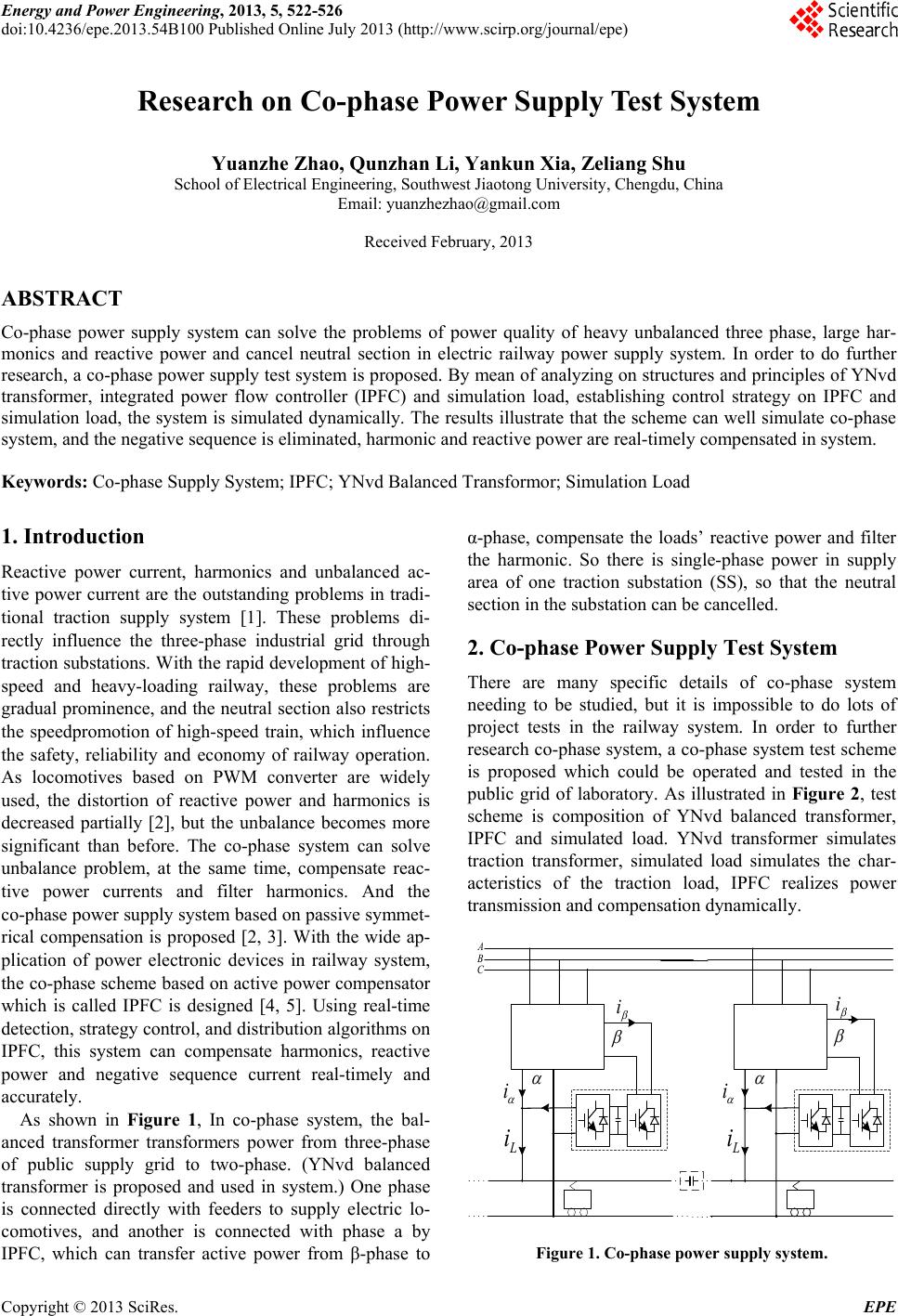
Energy and Power Engineering, 2013, 5, 522-526
doi:10.4236/epe.2013.54B100 Published Online July 2013 (http://www.scirp.org/journal/epe)
Research on Co-phase Power Supply Test System
Yuanzhe Zhao, Qunzhan Li, Yankun Xia, Zeliang Shu
School of Electrical Engineering, Southwest Jiaotong University, Chengdu, China
Email: yuanzhezhao@gmail.com
Received February, 2013
ABSTRACT
Co-phase power supply system can solve the problems of power quality of heavy unbalanced three phase, large har-
monics and reactive power and cancel neutral section in electric railway power supply system. In order to do further
research, a co-phase power supply test system is proposed. By mean of analyzing on structures and principles of YNvd
transformer, integrated power flow controller (IPFC) and simulation load, establishing control strategy on IPFC and
simulation load, the system is simulated dynamically. The results illustrate that the scheme can well simulate co-phase
system, and the negative sequence is eliminated, harmonic and reactive power are real-timely compensated in system.
Keywords: Co-phase Supply System; IPFC; YNvd Balanced Transformor; Simulation Load
1. Introduction
Reactive power current, harmonics and unbalanced ac-
tive power current are the outstanding problems in tradi-
tional traction supply system [1]. These problems di-
rectly influence the three-phase industrial grid through
traction substations. With the rapid development of high-
speed and heavy-loading railway, these problems are
gradual prominence, and the neutral section also restricts
the speedpromotion of high-speed train, which influence
the safety, reliability and economy of railway operation.
As locomotives based on PWM converter are widely
used, the distortion of reactive power and harmonics is
decreased partially [2], but the unbalance becomes more
significant than before. The co-phase system can solve
unbalance problem, at the same time, compensate reac-
tive power currents and filter harmonics. And the
co-phase power supply system based on passive symmet-
rical compensation is proposed [2, 3]. With the wide ap-
plication of power electronic devices in railway system,
the co-phase scheme based on active power compensator
which is called IPFC is designed [4, 5]. Using real-time
detection, strategy control, and distribution algorithms on
IPFC, this system can compensate harmonics, reactive
power and negative sequence current real-timely and
accurately.
As shown in Figure 1, In co-phase system, the bal-
anced transformer transformers power from three-phase
of public supply grid to two-phase. (YNvd balanced
transformer is proposed and used in system.) One phase
is connected directly with feeders to supply electric lo-
comotives, and another is connected with phase a by
IPFC, which can transfer active power from β-phase to
α-phase, compensate the loads’ reactive power and filter
the harmonic. So there is single-phase power in supply
area of one traction substation (SS), so that the neutral
section in the substation can be cancelled.
2. Co-phase Power Supply Test System
There are many specific details of co-phase system
needing to be studied, but it is impossible to do lots of
project tests in the railway system. In order to further
research co-phase system, a co-phase system test scheme
is proposed which could be operated and tested in the
public grid of laboratory. As illustrated in Figure 2, test
scheme is composition of YNvd balanced transformer,
IPFC and simulated load. YNvd transformer simulates
traction transformer, simulated load simulates the char-
acteristics of the traction load, IPFC realizes power
transmission and compensation dynamically.
i
L
i
A
C
i
L
i
i
i
Figure 1. Co-phase pow er supply system.
Copyright © 2013 SciRes. EPE